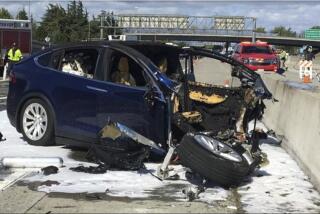The Cutting Edge: Computing / Technology / Innovation : Digital Back-Seat Driver Will Talk You There
- Share via
Auto navigation systems that display maps and directions have been showing up in high-priced cars for several years. Aside from cost, the main drawback of these digital maps is that they require drivers to take their eyes off the road to continually glance at the map.
But AudioNav, developed by Burbank-based Amerigon Inc. and scheduled for release later this year, allows you to literally tell the system where you want to go and receive voice directions on how to get there.
AudioNav, about the size of a VHS videotape, connects to a car’s compact disc player and carries on its dialogue with the driver using a microphone on the visor and the car’s stereo speakers. The dialogue, map and programs are recorded on CDs.
The driver spells street names or the names of landmarks related to his current location and ultimate destination. Using voice-recognition software, AudioNav identifies the place names on a map and plots the fastest route. It then reads back directions. Car audio system manufacturers Eclipse/Fujitsu Ten and Clarion plan to offer the AudioNav systems, which are expected to retail for $500 to $600.
*
Virtual Science Center: Despite its name, the Weizmann Institute of Science’s new BioMOO biology center has nothing to do with genetically engineered cows. MOO stands for Multiple-user dimension, Object Oriented and was coined to describe a multiple-user computer game.
But scientists who visit BioMOO aren’t playing games. They are participating in the first major effort to use a virtual environment for day-to-day science and science communications established by the Weizmann Institute in Rehovot, Israel. When you log into BioMOO, which can be accessed via the Internet, you can type “who” to find out who else is on the premises and where.
Want to find a fellow biologist working on glycosphingolipids? Leave a note on the bulletin board. To share the results of a research project, invite others to visit your lab. To discuss a key scientific paper, post a date, time and place and see who shows up at your seminar. BioMOO has more than 700 registered members.
*
Foiling Aphids: It might one day be a common sight for motorists along Interstate 5 to see painted silver farmland stretching into the distance. In a study to find new methods of preventing aphid attacks on crops, University of California entomologists have found that reflection works where insecticides don’t.
For plants that are highly susceptible to aphid-carried viruses that stunt growth, the discovery could lead to the first effective deterrent to aphids.
It seems that when an aphid is flying along looking for a landing spot, it cues off the reflection coming from plant surfaces. If an aphid sees a reflection of the sky, say in silver paint or a strip of aluminum foil, it won’t land.
Foil is an effective solution for back-yard gardeners. But it would be prohibitively expensive for commercial growers, and researchers are doing a three-year study of the effectiveness of spraying water-based silver paint on planting beds. When the crop is finished, the paint can be plowed under with no harmful effects.
*
Making Star Light, Star Bright: The technology available to scan the heavens has advanced to such a degree that astronomy, astrophysics and cosmology are said to be in a golden age of discovery. But advances in visual power are also bringing new technical challenges. One of the most formidable is the distortion caused by the Earth’s atmosphere on the captured image.
To correct distortions, astronomers are working with adaptive optics to restore light to its original condition. Adaptive optics use a bright object above the distorting layers of atmosphere, along with sensors that detect and measure the distortion. By utilizing a small, computer-controlled corrective mirror, the image can be repeatedly adjusted to cancel out atmospheric blurring.
The corrected imaging not only provides greater detail, it also enables telescopes to detect faint objects by compressing the light. To produce a bright source near the object under study, one proposal is to create an artificial “star” made with lasers. Scientists at Hawaii’s Keck Observatory say the technology may be ready by late 1997.






